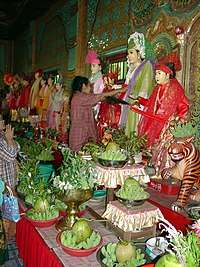Kartikeya
Kartikeya (IAST: Kārttikeya), also known as Murugan, Skanda, Kumara,[4] and Subrahmanya, is the Hindu god of war.[5][6][7] He is the son of Parvati and Shiva, brother of Ganesha, and a god whose life story has many versions in Hinduism.[8] An important deity around South Asia since ancient times, Kartikeya is particularly popular and predominantly worshipped in South India, Sri Lanka, Singapore and Malaysia as Murugan.[5][8][6]
| Kartikeya | |
|---|---|
God of War and Victory Commander of the Gods | |
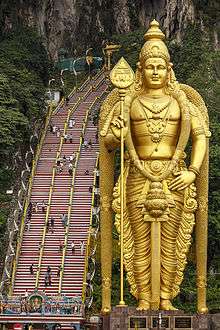 Statue of Kartikeya in Batu Caves temple | |
| Other names |
|
| Affiliation | Deva |
| Abode | Mount Kailash |
| Planet | Mangala |
| Mantra | |
| Weapon | |
| Animals |
|
| Day | Tuesday |
| Color | Red |
| Mount | Peacock |
| Gender | Male |
| Festivals |
|
| Personal information | |
| Parents | |
| Siblings |
|
| Consort | Devasena and Valli |
| Part of a series on |
| Hinduism |
|---|
 |
|
|
Main traditions
|
|
Concepts
|
|
Practices Worship
Arts
Festivals
|
|
Philosophical schools
|
|
Gurus, saints, philosophers
|
|
Texts Scriptures
Other texts
Text classification
|
|
Other topics
|
|
| Part of the series on |
| Kaumaram |
|---|
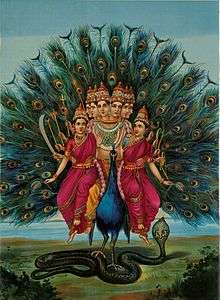 |
|
Sacred symbols
|
|
Six sacred abodes
|
|
Other temples
|
|
Kartikeya is an ancient god, traceable to the Vedic era. Archaeological evidence from 1st-century CE and earlier,[9] where he is found with Hindu god Agni (fire), suggest that he was a significant deity in early Hinduism.[5] He is found in many medieval temples all over India, such as at the Ellora Caves and Elephanta Caves.[10]
The iconography of Kartikeya varies significantly; he is typically represented as an ever-youthful man, riding or near a peacock, dressed with weapons sometimes near a rooster. Most icons show him with one head, but some show him with six heads reflecting the legend surrounding his birth where six mothers symbolizing the six stars of Pleiades cluster who took care of newly born baby Kartikeya.[5][8][6] He grows up quickly into a philosopher-warrior, destroys evil in the form of demon Taraka, teaches the pursuit of ethical life and the theology of Shaiva Siddhanta.[6][7] He has inspired many poet-saints, such as Arunagirinathar.[7][11]
Kartikeya is found as a primary deity in temples wherever communities of the Tamil people live worldwide, particularly in Tamil Nadu state of India, Sri Lanka, Mauritius, Indonesia, Malaysia, Singapore, South Africa and Réunion. Three of the six richest and busiest temples in Tamil Nadu are dedicated to him.[7] The Kataragama temple dedicated to him in Sri Lanka attracts Tamils, Sinhalese people and the Vedda people.[9] He is also found in other parts of India, sometimes as Skanda, but in a secondary role along with Ganesha, Parvati and Shiva.[6]
Etymology and nomenclature
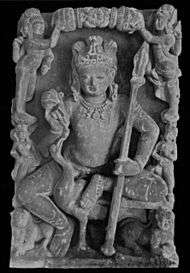
Kartikeya is known by numerous names in ancient and medieval texts of the Indian culture. Most common among these are Murugan, Kumara, Skanda, and Subrahmanya. Others include Aaiyyan, Cheyyon, Senthil, Vēlaṇ, Swaminatha ("ruler of the gods", from -natha king), śaravaṇabhava ("born amongst the reeds"), Arumugam or ṣaṇmukha ("six-faced"),[12] Dandapani ("wielder of the mace", from -pani hand), Guha (cave, secret) or Guruguha (cave-teacher), Kadhirvelan, Kandhan, Vishakha and Mahasena.[13] In ancient coins where the inscription has survived along with his images, his names appear as Kumara, Brahmanya or Brahmanyadeva.[14] On some ancient Indo-Scythian coins, his names appear in Greek script as Skanda, Kumara and Vishaka.[15] In ancient statues, he appears as Mahasena, Skanda and Vishakha.[16]
Skanda is derived from skanḍr-, which means "leaper or attacker".[17] In Kalidasa’s epic poem Kumarasambhava (“The Birth of the War God”; 5th century CE), as in most versions of the story, the gods wished for Skanda to be born in order to destroy the demon Taraka, who had been granted a boon that he could be killed only by a son of Shiva. They sent Parvati to induce Shiva to marry her. Shiva, however, was lost in meditation and was not attracted to Parvati until he was struck by an arrow from the bow of Kama, the god of love, whom he immediately burned to ashes. After many years of abstinence, Shiva’s seed was so strong that the gods, fearing the result, sent Agni, the god of fire, to interrupt Shiva’s amorous play with Parvati. Agni received the seed and dropped it into the Ganges, where Skanda was born.[18]
Kartikeya means "of the Krittikas".[6] This epithet is also linked to his birth. After he appears on the banks of the River Ganges, he is seen by the six of the seven brightest stars cluster in the night sky called Krittikas in Hindu texts (called Pleiades in Greek texts). These six mothers all want to take care of him and nurse baby Kartikeya. Kartikeya ends the argument by growing five more heads to have a total of six heads so he can look at all six mothers, and let them each nurse one.[6][19]
Textual references
Ancient
There are ancient references which can be interpreted to be Kartikeya in the Vedic texts, in the works of Pāṇini (~500 BCE), in the Mahabhasya of Patanjali and in Kautilya's Arthashastra.[20] For example, the term Kumara appears in hymn 5,2 of the Rig Veda.[21][note 1] The Kumara of verse 5.2.1 can be interpreted as Skanda, or just any "boy". However, the rest of the verses depict the "boy" as bright-colored, hurling weapons and other motifs that later have been associated with Skanda. The difficulty with interpreting these to be Skanda is that Indra, Agni and Rudra are also depicted in similar terms and as warriors.[22]

The Skanda-like motifs found in Rig Veda are found in other Vedic texts, such as section 6.1-3 of the Shatapatha Brahmana.[23] In these, the mythology is very different for Kumara, as Agni is described to be the Kumara whose mother is Ushas (goddess Dawn) and whose father is Purusha.[21] The section 10.1 of the Taittiriya Aranyaka mentions Sanmukha (six faced one), while the Baudhayana Dharmasutra mentions a householder's rite of passage that involves prayers to Skanda with his brother Ganapati (Ganesha) together.[24] The chapter 7 of the Chandogya Upanishad (~800–600 BCE) equates Sanat-Kumara (eternal son) and Skanda, as he teaches sage Narada to discover his own Atman (soul, self) as a means to the ultimate knowledge, true peace and liberation.[25][26][note 2]
According to Fred Clothey, the evidence suggests that Kartikeya mythology had become widespread sometime around 200 BCE or after in north India.[28] The first clear evidence of Kartikeya's importance emerges in the Hindu Epics such as the Ramayana and the Mahabharata where his story is recited. In addition to textual evidence, his importance is affirmed by the archeological, the epigraphical and the numismatic evidence of this period. For example, he is found in numismatic evidence linked to the Yaudheyas, a confederation of warriors in north India who are mentioned by ancient Pāṇini.[29] They ruled an area consisting of modern era Haryana, Punjab, Rajasthan and Uttar Pradesh (extending into Garhwal region, Uttarakhand).[29] They struck coins bearing the image of Skanda, and these coins are dated to be from before Kushan Empire era started.[29] During the Kushan dynasty era, that included much of northwest Indian subcontinent, more coins featuring Kartikeya were minted.[29] He is also found on ancient Indo-Scythian coins, where his various names are minted in Greek script.[15][note 3]
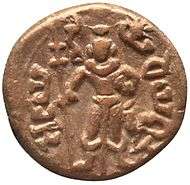
Kartikeya was revered in major cultural centers of ancient India. For example, he was a major god for the Ikshvakus, an Andhra dynasty, as well as for the Gupta Empire.[32] In south India, eight of the early Pallava dynasty rulers (300-550 CE) were named after Skanda or Kumara, suggesting the significance of Kartikeya by then.[33] Kalidasa's epic poem the Kumārasambhava features Kartikeya.
In Tamil literature
The Tolkāppiyam, one of the most ancient texts of the Tamil literature, mentions cēyōṉ "the red one", who is identified with Murugan, whose name is literally Murukaṉ "the youth"; the other gods referred to in the Tolkāppiyam are Māyōṉ "the dark one" (identified with Vishnu), Vēntaṉ "the sovereign" (identified with Indra) and Korravai "the victorious" (identified with Kali) and Varunan "the sea god".[34] Extant Sangam literature works, dated between the third century BCE and the fifth century CE glorified Murugan, "the red god seated on the blue peacock, who is ever young and resplendent," as "the favoured god of the Tamils."[35] Korravai is often identified as the mother of Murugan.[36]
In the Tirumurukāṟtruuppaṭai, he is called Muruku and described as a god of beauty and youth, with phrases such as "his body glows like the sun rising from the emerald sea". It describes him with six faces each with a function, twelve arms, his victory over evil, and the temples dedicated to him in the hilly regions.[37]
Puranas
Kartikeya is mentioned in Shaiva Puranas. Of these, the Skanda Purana is the largest Mahāpurāṇa, a genre of eighteen Hindu religious texts.[38] The text contains over 81,000 verses, and is part of Shaivite literature,[39] titled after Skanda, a son of Shiva and Parvati, who is also known as Kartikeya and Murugan.[40] While the text is named after Skanda, he does not feature either more or less prominently in this text than in other Shiva-related Puranas.[40] The text has been an important historical record and influence on the Hindu traditions related to war-god Skanda.[40][41] The earliest text titled Skanda Purana likely existed by the 6th-century CE,[42][43] but the Skanda Purana that has survived into the modern era exists in many versions.[44]
Buddhism
Early texts
The earliest mention of this deity in Buddhist texts may be found in the Janavasabha Sutta of the Pali Canon, where he is referred to as Sanankumāra. Here he is introduced as a deva of the rank of Mahābrahmā and a disciple of the Buddha.
The Chinese translation of the Dīrgha Āgama features the same deity with the title Brahmā[sanan]kumāra (梵童子). He is described as a manifestation of Mahābrahmārāja. He has five hair coils (頭五角髻), a handsome face (顏貌端正) and emanates purple-golden light (紫金色) that surpasses the light of the other devas.
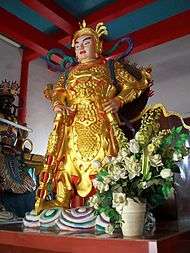
Theravada
According to Richard Gombrich, Skanda has been an important deity in Theravada Buddhism pantheon, in countries such as Sri Lanka and Thailand. The Nikaya Samgraha describes Skanda Kumara as a guardian deity of the land, along with Upulvan (Vishnu), Saman and Vibhisana.[46] Similarly, the 16th-century Siamese text Jinakalamali mentions him as a guardian god. There are Buddhist Sinhala shrines such as at Kataragama dedicated to Skanda which have historically been officiated by Hindu priests, which attracted Buddhist devotees and enjoyed royal support.[46] Since the 1950s, states Brian Morris, the Kataragama shrine of Skanda has attracted over half a million devotional pilgrims every year, most being Buddhists.[47][48]
Mahayana
The Mahāparinirvāṇa Sūtra mentions Kumāra as one of the eighty gods (八十神) worshiped by the common people.
The Ārya Kaṇikrodhavajrakumārabodhisattava Sādhanāvidhi Sūtra (聖迦抳忿怒金剛童子菩薩成就儀軌經) (T 1796) features a section for the recitation of a mantra dedicated to the deity, where he is also paired with Iśvara. Yi Xing's Commentary of the Mahāvairocana Tantra (大毘盧遮那成佛經疏) clarifies that Kumāra is the son of Iśvara.[49]
Sri Lanka
In Sri Lanka, the god Kataragama deviyo is a popular object of devotion among both Tamil Hindus and Sinhalese Buddhists. While many regard him as a bodhisattva, he is also associated with sensuality and retribution. Anthropologist Gananath Obeyesekere has suggested that the deity's popularity among Buddhists is due to his power to grant emotional gratification, which is in stark contrast to sensual restraint that characterizes Buddhist practice in Sri Lanka.[50]
China
In Chinese Buddhism, Skanda (also sometimes known as Kumāra (鳩摩羅天)) has been portrayed as Weituo (韋陀 or 韋馱), a young heavenly general, the guardian deity of local monasteries and the protector of Buddhist dhamma.[51][52] According to Henrik Sørensen, this representation became common after the Tang period, and became well established in the late Song period.[53] Skanda was also adopted by Korean Buddhism, and he appears in its woodblock prints and paintings.[53]
Jainism
According to Asko Parpola, the Jain deity Naigamesa, who is also referred to as Hari-Naigamesin, is depicted in early Jain texts as riding the peacock and as the leader of the divine army, both symbols of Kartikeya.[5]
Iconography

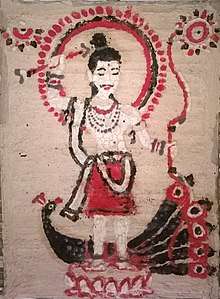
Ancient coins of the Yaudheyas, dated to 1st and 2nd century CE, show Kartikeya as a warrior with either one or six heads. Kushan coins show him with one head. In general, single head is far more common regardless of which dynasty minted them.[54] The earliest statues discovered in Punjab and Kashmir show him with either one or six heads. The oldest sculptures such as those found in Mathura show him with one head, while six head iconography is dated to post-Gupta Empire era.[55] All Kushan Empire era artwork show him with one head, even though there are Kushan deities such as a goddess who is shown with multiple heads.[19]
The Kushan Empire era statues of Kartikeya, dated to 1st and 2nd-century CE, have been found at various sites in the Indian subcontinent, particularly at Mathura and Gandhara. They show him as a warrior dressed in dhoti (sheet wrapped at waist, covering the legs), armour like a warrior, spear in his right hand and a bird (rooster) in his left.[56][57] There is some difference between his ancient iconography in Mathura and Gandhara artwork. The Gandhara arts show him in more a Scythian dress, likely reflecting the local dress culture prevalent in those times. Further, it is in the oldest Gandharan statues where he is shown with a bird that looks like a chicken or cock.[58] According to Richard Mann, the bird may symbolize Kartikeya's agility and maneuverability as a warrior god, and may be a Parthian influence.[58] His iconography symbolizes his attributes as a hunter, warrior and philosopher.[59]
Kartikeya iconography shows him as a youthful god, dressed as a warrior, carrying the weapon called Vel. It is a divine spear, often called sakti. He is sometimes depicted with many weapons including: a sword, a javelin, a mace, a discus and a bow although more usually he is depicted wielding the sakti or spear. His vahana (vehicle, mount) is a peacock. He has either one head or six, depending on the region or artist.[60][61]
Legends
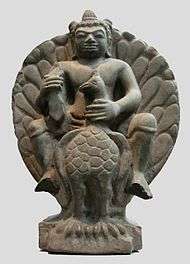
The Epic era literature of ancient India recite numerous legends of Kartikeya, often with his other names such as Skanda. For example, the Vana Parva of the Mahabharata dedicates chapters 223 to 232 to the legends of Skanda, but depicts him as the son of Agni and Svaha.[24] Similarly, Valmiki's Ramayana dedicates chapters 36 and 37 to Skanda, but describes him as the child of god Agni and goddess Ganges.[63]
The legends of Kartikeya vary significantly, sometimes within the same text. For example, while the Vana Parva of the Mahabharata describes Skanda as the son of Agni, the Shalya Parva and the Anushasana Parva of the same text presents Skanda's legend as the son of Maheshvara (Shiva) and Parvati.[24]
In Vana Parva, the circumstances behind Kartikeya's birth legend do not involve Shiva and Parvati.[64] Rather it is deity Agni who goes to a hermitage of seven married Rishis (sages) and meets their seven wives. He is sexually attracted to all seven, but none reciprocate. Svaha is present there and she is attracted to Agni, but Agni is not. According to the legend, Svaha takes the form of six of the wives, one by one, and sleeps with Agni.[64] She does not take the form of Arundhati, Vasistha's wife, because of Arundhati's extraordinary virtuous powers. Svaha deposits the semen of Agni into the reeds of River Ganges, where it develops and then is born as six headed Skanda.[64]
A totally different legend in the later books of the Mahabharata make Shiva and Parvati as the parents. They were making love, but they are disturbed, and Shiva inadvertently spills his semen on the ground.[6] Shiva's semen incubates in River Ganges, preserved by the heat of god Agni, and this fetus is born as baby Kartikeya on the banks of Ganges.[6][17]

Some legend state that he was the elder son of Shiva, others make him the younger brother of Ganesha. This is implied by another legend connected to his birth. Devas have been beaten up by Asuras led by Taraka, because Taraka had a boon from ascetic celibate yogi Shiva that only Shiva's son can kill him. Devas learn about this boon, and plan how to get Shiva into a relationship. So they bring Parvati into the picture, have her seduce yogi Shiva, and wed Parvati so that Skanda can be born to kill Taraka.[65]
According to Raman Varadara, Murugan or Kartikeya was originally a Tamil deity, who was adopted by north Indians.[66] He was the god of war in the Dravidian legends, and became so elsewhere in the Indian subcontinent too.[66] In contrast, G. S. Ghurye states that according to the archeological and epigraphical evidence, the contemporary Murugan, Subrahmanya and Kartikeya is a composite of two influences, one from south and one from north in the form of Skanda and Mahasena.[67] He as the warrior-philosopher god was the patron deity for many ancient northern and western Hindu kingdoms, and of the Gupta Empire, according to Ghurye. After the 7th-century, Skanda's importance diminished while his brother Ganesha's importance rose in the west and north, while in the south the legends of Murugan continued to grow.[67][68] According to Norman Cutler, Kartikeya-Murugan-Skanda of South and North India coalesced over time, but some aspects of the South Indian iconography and mythology for Murugan have remained unique to Tamil Nadu.[69]
Kartikeya's legends vary by region. For example, in the northern and western Indian traditions Kartikeya or Skanda is the perpetual celibate bachelor who never marries, but in the Tamil legends he has two consorts, Valli and Devasena.[66] Many of the major events in Murugan's life take place during his youth, and legends surrounding his birth are popular in Tamil Nadu. This has encouraged the worship of Murugan as a child-God, very similar to the worship of the child Krishna in north India. Kartikeya's youth, beauty and bravery was much celebrated in Sanskrit works like the Kathasaritsagara. Kalidasa made the birth of Kumara the subject of a lyrical epic, the Kumārasambhava.[63][70]
Theology
You who has form and who is formless,
you who are both being and non-being,
who are the fragrance and the blossom,
who are the jewel and its lustre,
who are the seed of life and life itself,
who are the means and the existence itself,
who are the supreme guru, come
and bestow your grace, O Guha [Murugan]
—Kantaranuputi 51, Arunagirinathar
(Translator: Kamil Zvelebil)[71]
There is extensive Hindu symbolism and theology associated with Kartikeya. Regardless of the variance among the legends, his birth is in difficult circumstances, he is born through a surrogate after being left near a river. He is raised not by his natural mother but a host of mothers, but later he is a part of his biological family. Kartikeya symbolizes a union of polarities.[72] He is handsome warrior and described as a celibate yogi. He uses his creative martial abilities to lead an army against Taraka and other demons, and described as a philosopher-warrior.[6][7] He is a uniter, championing the attributes of both Shaivism and Vaishnavism.[73]
His theology is most developed in the Tamil texts,[11] and in the Shaiva Siddhanta tradition.[6][7] He is described as dheivam (abstract neuter divinity, nirguna Brahman), as kadavul (divinity in nature, in everything), as Devan (masculine deity), and as iraivativam (concrete manifestation of the sacred, saguna Brahman).[74]
According to Fred Clothey, as Murugan (also referred to as Murugan, Cheyyon), he embodies the "cultural and religious whole that comprises South Indian Shaivism".[72] He is the philosopher and exponent of Shaiva Siddhanta theology, as well as the patron deity of the Tamil language.[75][76][59]
Worship
Within India
South India
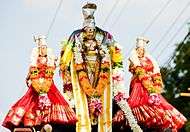
Kartikeya is a major deity among the Hindus of Tamil Nadu, Kerala, Karnataka, Andhra Pradesh and Telangana.
- Tamil Nadu
He is considered the God of Tamil language and he is mentioned a lot in Tamil Sangam literature.[35] The six abodes of Murugan are all in Tamil Nadu. Each of these temples has a unique history and different reason to worship Lord Murugan.Thirupparamkunram Murugan Temple he is worshiped as he (Lord Kartikeya) worshiped Lord Shiva. As per tradition, devotes who go to the six abodes of Murugan tonsure their head in imitation of Palani deity.
- Thai Poosam during January – February month is celebrated as a 6-day festival. On Thai Poosam day, Kavadis and Palkudams are taken by devotees in procession around Chhedanagar. Special Abhishekams are performed to the Moolavar and Utsavar. Annadhanam is provided to all devotees participating in the functions. In the night, Lord Muruga is taken in procession accompanied by Nadaswaram, Veda Parayanam around Chhedanagar.[77]
- Vaikasi Visakam day, (during May –June month), Kavadis and Palkudams are taken by devotees in procession around Chhedanagar.[77]
- Skanda Sashti during October-November month is celebrated as a 6-day festival. Spiritual discourses by learned scholars and/or music concerts by popular artists from South or from Mumbai are organized.[77]
Beyond India
Malaysia
Kartikeya is revered by the Hindus in Malaysia and other South-East Asian countries such as Singapore and Indonesia. Thaipusam is one of the important festivals celebrated. Sri Subramanyar Temple at Batu Caves temple complex in Malaysia is dedicated to Kartikeya. There are some other temples in Malaysia such as:
Sri Lanka
Karthikeya is worshipped by the Sinhalese as Kataragama deviyo also by Sri Lankan Tamils as Muruhan, a guardian deity of Sri Lanka. Numerous temples exist throughout the island. He is a favourite deity of the common folk everywhere and it is said he never hesitates to come to the aid of a devotee when called upon. In the deeply Sinhalese south of Sri Lanka, he is worshipped at the Kataragama temple, where he is known as Kathiravel or Kataragama deviyo. Local legend holds that Murugan alighted in Kataragama and was smitten by Valli, one of the local girls. After a courtship, they were married. This event is taken to signify that Murugan is accessible to all who worship and love him, regardless of their birth or heritage. The Nallur Kandaswamy temple, the Maviddapuram Kandaswamy Temple and the Sella Channithy Temple near Valvettiturai are the three foremost Murugan temples in Jaffna. The Chitravelayutha temple in Verukal on the border between Trincomalee and Batticaloa is also noteworthy as is the Mandur Kandaswamy temple in Batticaloa. The late medieval-era temple of the tooth in Kandy, dedicated to the tooth relic of the Buddha, has a Kataragama deiyo shrine adjacent to it dedicated to the veneration of Skanda in the Sinhalese tradition. Almost all Buddhist temples house a shrine room for Kataragama deviyo reflecting the significance of Murugan in Sinhala Buddhism.
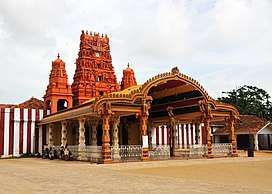
By the 16th century, the Kataragama temple had become synonymous with Skanda-Kumara who was a guardian deity of Sinhala Buddhism.[82] The town was popular as a place of pilgrimage for Hindus from India and Sri Lanka by the 15th century. The popularity of the deity at the Kataragama temple was also recorded by the Pali chronicles of Thailand such as Jinkalmali in the 16th century. There are number of legends both Buddhist and Hindu that attribute supernatural events to the very locality.[82] Scholars such as Paul Younger and Heinz Bechert speculate that rituals practiced by the native priests of Kataragama temple betray Vedda ideals of propitiation. Hence they believe the area was of Vedda veneration that was taken over by the Buddhist and Hindus in the medieval period.[83]
Temples
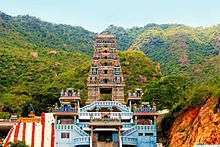
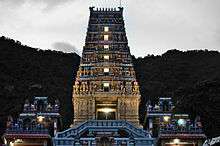
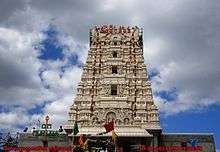
This is not an exhaustive list.
Within India
South India
Tamil Nadu
- Palani Murugan Temple
- Swamimalai Murugan Temple
- Thiruchendur Murugan Temple
- Thirupparamkunram Murugan Temple
- Thiruthani Murugan Temple
- Pazhamudircholai Murugan Temple
The above six temples are dedicated to Kartikeya as their primary deity.[84] These six temples in Tamil Nadu, together are referred to as Aru Padaiveedu (Tamil: Āṟupaṭai vīṭu), that are mentioned in Thirumurugatrupadai, written by Nakkeerar and in Thirupugal, written by Arunagirinathar.[85][86]
Kerala
There are many temples dedicated to Subramanya in Kerala such as:
- Atiyambur Sri Subramanya Temple in Kanhangad Kasaragod[87]
- Subramanya Swamy temple in Payyanur[88]
- Panmana Subramanya Swamy temple in Panmana[89]
- Haripad Sree Subrahmanya Swamy temple
- Kilimarathukavu Subrahmanya Temple
Andhra Pradesh
Anantapur District Pampanuru Subramanyam Swamy temple Kothur, Kurnool District
Karnataka
North India
Delhi
- Malai Mandir, a prominent temple complex[98]
Punjab
- Achaleshwar Temple in Gurdaspur.[100]
Chandigarh
- Sri Karthikeya Swami Temple[101]
Uttrakhand
- Karthik Swami temple above Rudraprayag[103]
Madhya pradesh
- Kartikeya Mandir, Gwalior. It opens only once a day in an year.[104]
Gujarat
- Sri Balamurugan Devasthanam in Ahmedabad[105]
Maharashtra
West Bengal
- Sri Ganesh & Murugan Temples in Kolkatta[107]
Outside India
Sri Lanka
- Kataragama (Kadirgamam) in the south[108]
- Temple in Tirukovil in the east
- Shrine in Embekke in Kandy
- Nallur Kandaswamy temple in Jaffna.
Malaysia
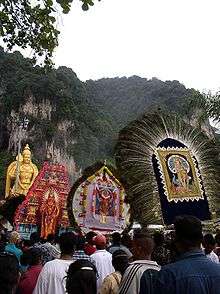
- Batu Caves near Kuala Lumpur which has a 42.7-m-high statue of Murugan at the entrance, the largest Lord Murugan statue in the world.[109][110]
- Arulmigu Balathandayuthapani Temple, Penang
- Nattukkottai Chettiar Temple, Penang
- Sri Marathandavar Bala Dhandayuthapani Alayam
- Sri Kandaswamy Kovil, Brickfields
- Sannasimalai Temple in Malacca.
- Kallumalai Temple in Ipoh
Indonesia
- Langkat, Indonesia which has 16 meter high and standing outside of its temple named as Shri Raja Rajeshwari Amman Kovil Temple. It has second largest Murugan statue in the world.
Singapore
USA
Canada
- Kanthasamy Temple in Toronto, Ontario, Canada
- Murugan temple in Val-Morin, a suburb of the city of Montreal[114].
United Kingdom
Australia
New Zealand
- Thirumurugan Temple in Auckland[123]
- Kurinji Kumaran Temple in Wellington[124]
Switzerland
- Sri Sivasubramaniar Temple, located in the Sihl Valley in Adliswil is the largest Hindu temple in Switzerland.[125]
South Africa
- Clairwood Shree Siva Soobramoniar Temple
Fiji
- Sri Siva Subramaniya temple
Notes
- कुमारं माता युवतिः समुब्धं गुहा बिभर्ति न ददाति पित्रे । अनीकमस्य न मिनज्जनासः पुरः पश्यन्ति निहितमरतौ ॥१॥ कमेतं त्वं युवते कुमारं पेषी बिभर्षि महिषी जजान । पूर्वीर्हि गर्भः शरदो ववर्धापश्यं जातं यदसूत माता ॥२॥ हिरण्यदन्तं शुचिवर्णमारात्क्षेत्रादपश्यमायुधा मिमानम् । ददानो अस्मा अमृतं विपृक्वत्किं मामनिन्द्राः कृणवन्ननुक्थाः ॥३॥ क्षेत्रादपश्यं सनुतश्चरन्तं सुमद्यूथं न पुरु शोभमानम् । न ता अगृभ्रन्नजनिष्ट हि षः पलिक्नीरिद्युवतयो भवन्ति ॥४॥ (...) Hymn 5.2, Wikisource;
English: "The youthful Mother keeps the Boy in secret pressed to her close, nor yields him to the Father. But, when he lies upon the arm, the people see his unfading countenance before them. [5.2.1] What child is this thou carriest as handmaid, O Youthful One? The Consort-Queen hath bome him. The Babe unborn increased through many autumns. I saw him born what time his Mother bare him. [5.2.2] I saw him from afar gold-toothed, bright-coloured, hurling his weapons from his habitation, What time I gave him Amrta free from mixture. How can the Indraless, the hymnless harm me? [5.2.3] I saw him moving from the place he dwells in, even as with a herd, brilliantly shining. These seized him not: he had been born already. They who were grey with age again grow youthful. [5.2.4]
– Translated by Ralph T.H. Griffith, Wikisource - Verse 7.26.2 states Kumara is Skanda, but there are stylistic differences between this verse and the rest of the chapter. This may be because this verse was interpolated into the text at a later date.[27]
- Richard Mann states that Skanda-Kumara may be composite deity linked to Greek deities pair called Dioscuri (Castor and Pollux), given the numismatic overlap in their iconography and similar warrior-god mythologies.[30]
References
- "Archived copy". Archived from the original on 17 November 2017. Retrieved 9 June 2018.CS1 maint: archived copy as title (link)
- "The meaning of arohara". Archived from the original on 11 September 2019. Retrieved 24 April 2019.
- https://www.deccanherald.com/content/373661/land-snake-god.html#main-content Archived 25 April 2017 at the Wayback Machine
- James G. Lochtefeld 2002, p. 377.
- Asko Parpola 2015, p. 285.
- James G. Lochtefeld 2002, pp. 655-656.
- Fred W. Clothey 1978, pp. 1-2.
- Constance Jones & James D. Ryan 2006, p. 228.
- G Obeyesekere (2004). Jacob Kẹhinde Olupona (ed.). Beyond Primitivism: Indigenous Religious Traditions and Modernity. Routledge. pp. 272–274. ISBN 978-0-415-27319-0.
- T. A. Gopinatha Rao 1993, p. 40.
- Mohan Lal 1992, p. 4339.
- Gopal, Madan (1990). K.S. Gautam (ed.). India through the ages. Publication Division, Ministry of Information and Broadcasting, Government of India. p. 80.
- Fred W. Clothey 1978, pp. 1, 22-25, 35-39, 49-58, 214-216.
- Richard D. Mann 2011, pp. 104-106 with footnotes.
- Edward Thomas (1877). Jainism: Or, The Early Faith of Aṣoka. Trübner & Company. pp. 60, 62 (see e.g. coin 11). Archived from the original on 10 June 2017. Retrieved 28 January 2020.
- Richard D. Mann 2011, pp. 123-124.
- Fred W. Clothey 1978, pp. 49, 54-55.
- "Skanda | Hindu deity". Encyclopedia Britannica. Archived from the original on 3 December 2018. Retrieved 18 April 2019.
- Doris Srinivasan 1997, pp. 302-303, 333-334.
- Fred W. Clothey 1978, pp. 49-53.
- Fred W. Clothey 1978, pp. 49-51.
- Fred W. Clothey 1978, pp. 46-51.
- Fred W. Clothey 1978, pp. 48-50.
- Fred W. Clothey 1978, pp. 50-51.
- Fred W. Clothey 1978, pp. 49-50.
- The Thirteen Principal Upanishads Archived 25 May 2017 at the Wayback Machine, Robert Hume, Oxford University Press, pages 250-262
- The Thirteen Principal Upanishads Archived 25 May 2017 at the Wayback Machine, Robert Hume, Oxford University Press, page 262 with footnote 3
- Fred W. Clothey 1978, pp. 45-46.
- Richard D. Mann 2011, pp. 101-105 with footnotes.
- Benjamin Fleming; Richard Mann (2014). Material Culture and Asian Religions: Text, Image, Object. Routledge. pp. 234–246. ISBN 978-1-135-01373-8. Archived from the original on 22 April 2017. Retrieved 21 April 2017.
- Richard D. Mann 2011, pp. 101-103.
- Ratna Navaratnam; Karttikeya, the divine child:the Hindu testament of wisdom, 1973, Bharatiya Vidya Bhavan
- Fred W. Clothey 1978, p. 22.
- Journal of Tamil Studies, Volume 1. International Institute of Tamil Studies. 1969. p. 131. Archived from the original on 13 November 2017.
- Kanchan Sinha, Kartikeya in Indian art and literature, Delhi: Sundeep Prakashan (1979).
- Korravai Archived 7 November 2017 at the Wayback Machine 2017-11-1. Britannica Online
- The Smile of Murugan on Tamil Literature of South India Archived 23 February 2017 at the Wayback Machine, by Kamil Zvelebil (1973), E.J. Brill, pages 125-127
- Ganesh Vasudeo Tagare (1996). Studies in Skanda Purāṇa. Published by Motilal Banarsidass, ISBN 81-208-1260-3
- Hans Bakker 2014, pp. 4-6.
- Rocher 1986, pp. 114, 229-238.
- KK Kurukkal (1961), A Study of the Karttikeya Cult as reflected in the Epics and the Puranas, University of Ceylon Review, Vol. 19, pages 131-138
- Richard D. Mann 2011, p. 187.
- Hans Bakker 2014, pp. 1-3.
- Doniger 1993, pp. 59-83.
- Robert E. Buswell Jr.; Donald S. Lopez Jr. (2013). The Princeton Dictionary of Buddhism. Princeton University Press. p. 452. ISBN 978-1-4008-4805-8. Archived from the original on 21 April 2017. Retrieved 20 April 2017.
- Richard Francis Gombrich; Gananath Obeyesekere (1988). Buddhism Transformed: Religious Change in Sri Lanka. Motilal Banarsidass. pp. 176–180. ISBN 978-81-208-0702-0. Archived from the original on 20 April 2017. Retrieved 19 April 2017.
- Brian Morris (2006). Religion and Anthropology: A Critical Introduction. Cambridge University Press. pp. 68–69. ISBN 978-0-521-85241-8. Archived from the original on 20 April 2017. Retrieved 19 April 2017.
- Kevin Trainor (2004). Buddhism: The Illustrated Guide. Oxford University Press. pp. 123–124. ISBN 978-0-19-517398-7. Archived from the original on 20 April 2017. Retrieved 19 April 2017.
- Chia, Siang Kim (2016). "鳩摩羅天". Digital Dictionary of Buddhism. Retrieved 5 November 2019.
- Trainor, Kevin, ed. (2001). Buddhism: The Illustrated Guide. New York, NY: Oxford University Press. p. 123. ISBN 0-19-521849-3.
- Richard D. Mann 2011, p. 32 with footnote 24.
- Angela Falco Howard (2006). Chinese Sculpture. Yale University Press. pp. 373, 380–381. ISBN 0-300-10065-5. Archived from the original on 20 April 2017. Retrieved 19 April 2017.
- Henrik Sørensen (2011). Charles Orzech; Henrik Sørensen; Richard Payne (eds.). Esoteric Buddhism and the Tantras in East Asia. BRILL Academic. pp. 124–125, 654–655 with footnotes. ISBN 90-04-18491-0. Archived from the original on 20 April 2017. Retrieved 19 April 2017.
- Richard D. Mann 2011, pp. 111-114.
- Richard D. Mann 2011, pp. 113-114, 122-126.
- Richard D. Mann 2011, pp. 122-126.
- Doris Srinivasan 2007, pp. 333-335.
- Richard D. Mann 2011, pp. 124-126.
- S. Xavier Alphonse (1997). Kanthapura to Malgudi: Cultural Values and Assumptions in Selected South Indian Novelists in English. Prestige. p. 167. ISBN 978-81-7551-030-2. Archived from the original on 20 April 2017. Retrieved 19 April 2017., Quote: "He [Skanda] has been hunter, warrior, philosopher. He is the teacher and inspiration of literature and arts. He is the eternal child, as old as time itself, yet as young as every new beginning. He is the handsome hero and lover, the wise Primordial One."
- Richard D. Mann 2011, pp. 123-126 with footnotes.
- Doris Srinivasan 2007, pp. 333-336, 515-516.
- John Guy (2014). Lost Kingdoms: Hindu-Buddhist Sculpture of Early Southeast Asia. Metropolitan Museum of Art. pp. 176–178. ISBN 978-1-58839-524-5. Archived from the original on 23 December 2016. Retrieved 19 April 2017.
- Fred W. Clothey 1978, p. 51.
- Fred W. Clothey 1978, pp. 51-52.
- Fred W. Clothey 1978, pp. 54-56.
- Raman Varadara 1993, pp. 113-114.
- Govind Sadashiv Ghurye (1977). Indian Acculturation: Agastya and Skanda. Popular Prakashan. pp. 152–167. Archived from the original on 5 January 2019. Retrieved 19 April 2017.
- S. Devadas Pillai (1997). Indian Sociology Through Ghurye, a Dictionary. Popular Prakashan. pp. 159–160. ISBN 978-81-7154-807-1. Archived from the original on 20 April 2017. Retrieved 19 April 2017.
- Norman Cutler (2008). Gavin Flood (ed.). The Blackwell Companion to Hinduism. John Wiley & Sons. p. 146. ISBN 978-0-470-99868-7. Archived from the original on 23 December 2019. Retrieved 21 April 2017.
- Kālidāsa; C.R. Devadhar (Translator) (1985). Kumara-Sambhava of Kalidasa. Motilal Banarsidass. pp. iii–viii. ISBN 978-81-208-0012-0. Archived from the original on 20 April 2017. Retrieved 19 April 2017.
- Kamil Zvelebil (1973). The Smile of Murugan: On Tamil Literature of South India. BRILL Academic. p. 243. ISBN 90-04-03591-5. Archived from the original on 20 April 2017. Retrieved 19 April 2017.
- Fred W. Clothey 1978, p. 3.
- Fred W. Clothey 1978, pp. 3-4.
- Fred W. Clothey 1978, pp. 10-14.
- James G. Lochtefeld (2002). The Illustrated Encyclopedia of Hinduism: A-M. The Rosen Publishing Group. p. 450. ISBN 978-0-8239-3179-8. Archived from the original on 16 March 2020. Retrieved 28 January 2020.
- Vijaya Ramaswamy (2007). Historical Dictionary of the Tamils. Scarecrow Press. pp. 152–153. ISBN 978-0-8108-6445-0. Archived from the original on 19 April 2017. Retrieved 19 April 2017.
- Site, Temple Official. "Cheddanagar Temple". www.thiruchemburmurugan.com. Archived from the original on 15 September 2018. Retrieved 9 September 2018.
- "Tour Information". ICHSS. Archived from the original on 27 October 2018. Retrieved 2 September 2018.
- A, Jeyaraj. "Hindu Temples In Ipoh". ipohecho. Archived from the original on 2 September 2018. Retrieved 2 September 2018.
- "Ipoh Kallumalai Murugan Temple, Ipoh". Inspirock. Archived from the original on 2 September 2018. Retrieved 2 September 2018.
- Star, The. "10,000 celebrate Masi Magam festival Sannayasi Andavar Temple in Cheng". The Star. Archived from the original on 2 September 2018. Retrieved 2 September 2018.
- Pathmanathan, S (September 1999). "The guardian deities of Sri Lanka: Skanda-Murgan and Kataragama". The journal of the institute of Asian studies. The institute of Asian studies. Archived from the original on 26 September 2010.
- Bechert, Heinz (1970). "Skandakumara and Kataragama: An Aspect of the Relation of Hinduism and Buddhism in Sri Lanka". Proceedings of the Third International Tamil Conference Seminar. Paris: International Association of Tamil Research. Archived from the original on 25 September 2010.
- Clothey, Fred W. (1972). "Pilgrimage Centers in the Tamil Cultus of Murukan". Journal of the American Academy of Religion. 40 (1): 79–95. doi:10.1093/jaarel/XL.1.79. JSTOR 1461919.
- hithra Madhavan, Prema Kasturi (2007). South India Heritage: An Introduction. East West Books (madras) Pvt Ltd. ISBN 978-8188661640. Retrieved 17 August 2018.
- Outlook, Travelers (30 July 2008). Outlook Publishing (India). 8189449036. ISBN 978-8189449032. Retrieved 17 August 2018.
- "Sri Subrahmanya Swami Temple". Archived from the original on 17 August 2018. Retrieved 17 August 2018.
- Mathew, Biju. Pilgrimage to Temple Heritage. Info Kerala Communications. ISBN 819212844X. Retrieved 17 August 2018.
- "Sree Subramanya Swamy Temple". Kerela Tourism. Archived from the original on 17 August 2018. Retrieved 17 August 2018.
- "Official website of temple". Archived from the original on 6 August 2018. Retrieved 15 August 2018.
- "Sri Subrahmanyaswamy Temple, Skandagiri, Secunderabad". Trip Advisor. Archived from the original on 15 August 2018. Retrieved 15 August 2018.
- "Sri Subrahmanya Devalayam". Official website of temple. Archived from the original on 22 August 2018. Retrieved 15 August 2018.
- "Sir Subrahmanyeswara Swamy Temple". Official website of temple. Archived from the original on 15 August 2018. Retrieved 15 August 2018.
- "Mallamu Subramanyaswamy temple". Prudwi. Archived from the original on 15 August 2018. Retrieved 15 August 2018.
- "Sri Subramanyeswara Swamy Temple, Mallam". 1nellore. Archived from the original on 15 August 2018. Retrieved 15 August 2018.
- "Kukke Subrahmanya Temple". Archived from the original on 28 April 2010. Retrieved 15 August 2018.
- "Kukke Subramanya temple". Archived from the original on 15 August 2018. Retrieved 15 August 2018.
- "Uttara Swami Malai Temple". Official website of temple. Archived from the original on 15 August 2018. Retrieved 15 August 2018.
- "Kartikeya Temple". Haryana tourism. Archived from the original on 15 August 2018. Retrieved 15 August 2018.
- "About Achaleshwar Temple". Yatra. Archived from the original on 17 August 2018. Retrieved 17 August 2018.
- "Sri Karthikeya Swami Temple". Archived from the original on 17 August 2018. Retrieved 17 August 2018.
- "Kartik Swami Temple – Feel Connected with Extreme Power of Almighty". Archived from the original on 17 August 2018. Retrieved 17 August 2018.
- Times, Hindustan (1 April 2017). "Himalaya's hidden gem: Pilgrimage to Karthik Swami temple". Archived from the original on 8 December 2018. Retrieved 23 August 2018.
- Jaiswal, Rishi. "Temple dedicated to Shiva's son, Karthikeya opens only once an year". Bhaskar. Archived from the original on 25 August 2018. Retrieved 23 August 2018.
- "Sri Balamurugan Devasthanam". Official website of temple. Archived from the original on 1 April 2018. Retrieved 23 August 2018.
- "Aalya Thiruppani Kuzhu". Official website of temple. Archived from the original on 20 August 2018. Retrieved 23 August 2018.
- Dutta, Samarpan (26 August 2004). "Temple ties in culture cauldron". Telegraph. Archived from the original on 8 August 2016. Retrieved 23 August 2018.
- "Kataragama". Lanka. Archived from the original on 15 August 2018. Retrieved 15 August 2018.
- Star, The. "Tallest statue of deity unveiled". Archived from the original on 15 August 2018. Retrieved 15 August 2018.
- "Batu Caves". Britannica. Archived from the original on 15 August 2018. Retrieved 15 August 2018.
- "Home Page of Sri Thendayuthapani Temple". Official website of temple. Archived from the original on 6 July 2015. Retrieved 15 August 2018.
- "Shiva Murugan Temple". Shiva Murugan Temple. Archived from the original on 14 April 2008. Retrieved 15 August 2018.
- "Hindu temple headed for banks of Deep River". Chatham News+Record. Retrieved 22 April 2019.
- "Explanation of Deities". Official website of temple. Archived from the original on 22 August 2018. Retrieved 15 August 2018.
- "HIGHGATEHILL MURUGAN TEMPLE". Official website of temple. Archived from the original on 9 August 2018. Retrieved 16 August 2018.
- "The London Sri Murugan". Official website of temple. Archived from the original on 9 August 2018. Retrieved 16 August 2018.
- "Leicester Shri Murugan (Hindu) Temple". Registered charities in England. Archived from the original on 16 August 2018. Retrieved 16 August 2018.
- "Sri Murugan Temple". Official visitor website for Leicestershire. Archived from the original on 17 August 2018. Retrieved 16 August 2018.
- "Lord Murugan Temple". Official website of temple. Archived from the original on 16 August 2018. Retrieved 16 August 2018.
- "Sydeny Murugan Temple". Official website of temple. Archived from the original on 16 August 2018. Retrieved 16 August 2018.
- "Perth Bala Murugan". Official website of temple. Archived from the original on 16 August 2018. Retrieved 16 August 2018.
- "Kundrathu Kumaran Temple". Official website of temple. Archived from the original on 16 August 2018. Retrieved 16 August 2018.
- "New Zealand Thirumurugan Temple". Official website of temple. Archived from the original on 15 August 2018. Retrieved 16 August 2018.
- Reeves, Peter (7 March 2014). The Encyclopedia of the Sri Lankan Diaspora. Didier Millet. ISBN 9814260835. Retrieved 16 August 2018.
- "Hinduismus :::: Religionen in der Schweiz / Religions en Suissse :::: Universität Luzern". 2 June 2009. Archived from the original on 15 February 2015.
Bibliography
- Hans Bakker (2014). The World of the Skandapurāṇa. BRILL Academic. ISBN 978-90-04-27714-4.CS1 maint: ref=harv (link)
- Fred W. Clothey (1978). The Many Faces of Murukan̲: The History and Meaning of a South Indian God. Walter de Gruyter. ISBN 978-90-279-7632-1.CS1 maint: ref=harv (link)
- Doniger, Wendy, ed. (1993). Purāṇa Perennis: Reciprocity and Transformation in Hindu and Jaina Texts. Albany, New York: State University of New York. ISBN 0-7914-1382-9.CS1 maint: ref=harv (link)
- Constance Jones; James D. Ryan (2006). Encyclopedia of Hinduism. Infobase Publishing. ISBN 978-0-8160-7564-5.CS1 maint: ref=harv (link)
- Richard D. Mann (2011). The Rise of Mahāsena: The Transformation of Skanda-Kārttikeya in North India from the Kuṣāṇa to Gupta Empires. BRILL. ISBN 978-90-04-21886-4.CS1 maint: ref=harv (link)
- Asko Parpola (2015). The Roots of Hinduism: The Early Aryans and the Indus Civilization. Oxford University Press. ISBN 978-0-19-022691-6.CS1 maint: ref=harv (link)
- T. A. Gopinatha Rao (1993). Elements of Hindu iconography. Motilal Banarsidass. ISBN 978-81-208-0878-2.CS1 maint: ref=harv (link)
- Mohan Lal (1992). Encyclopaedia of Indian Literature. Sahitya Akademi. ISBN 978-81-260-1221-3.CS1 maint: ref=harv (link)
- James G. Lochtefeld (2002). The Illustrated Encyclopedia of Hinduism: N-Z. The Rosen Publishing Group. ISBN 978-0-8239-3180-4.CS1 maint: ref=harv (link)
- Rocher, Ludo (1986). The Puranas. Otto Harrassowitz Verlag. ISBN 978-3447025225.CS1 maint: ref=harv (link)
- Mani, Vettam. Puranic Encyclopedia. 1st English ed. New Delhi: Motilal Banarsidass, 1975.
- G. V. Tagare, Dr. The Skanda-Purana (23 Vols.), Motilal Banarsidass. 2007.
- Kaur, Jagdish (1979). "Bibliographical Sources for Himalayan Pilgrimages and Tourism Studies: Uttarakhand". Tourism Recreation Research. 4 (1): 13–16. doi:10.1080/02508281.1979.11014968.
- Doris Srinivasan (2007). On the Cusp of an Era: Art in the Pre-Kuṣāṇa World. BRILL Academic. ISBN 90-04-15451-5.CS1 maint: ref=harv (link)
- Doris Srinivasan (1997). Many Heads, Arms, and Eyes: Origin, Meaning, and Form of Multiplicity in Indian Art. BRILL Academic. ISBN 90-04-10758-4.CS1 maint: ref=harv (link)
- Raman Varadara (1993). Glimpses of Indian Heritage. Popular Prakashan. ISBN 978-81-7154-758-6.CS1 maint: ref=harv (link)
External links
| Wikimedia Commons has media related to Murugan. |
.jpg)


